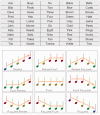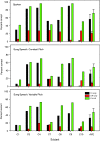Perception of Sung Speech in Bimodal Cochlear Implant Users
- PMID: 27837051
- PMCID: PMC5117252
- DOI: 10.1177/2331216516669329
Perception of Sung Speech in Bimodal Cochlear Implant Users
Abstract
Combined use of a hearing aid (HA) and cochlear implant (CI) has been shown to improve CI users' speech and music performance. However, different hearing devices, test stimuli, and listening tasks may interact and obscure bimodal benefits. In this study, speech and music perception were measured in bimodal listeners for CI-only, HA-only, and CI + HA conditions, using the Sung Speech Corpus, a database of monosyllabic words produced at different fundamental frequencies. Sentence recognition was measured using sung speech in which pitch was held constant or varied across words, as well as for spoken speech. Melodic contour identification (MCI) was measured using sung speech in which the words were held constant or varied across notes. Results showed that sentence recognition was poorer with sung speech relative to spoken, with little difference between sung speech with a constant or variable pitch; mean performance was better with CI-only relative to HA-only, and best with CI + HA. MCI performance was better with constant words versus variable words; mean performance was better with HA-only than with CI-only and was best with CI + HA. Relative to CI-only, a strong bimodal benefit was observed for speech and music perception. Relative to the better ear, bimodal benefits remained strong for sentence recognition but were marginal for MCI. While variations in pitch and timbre may negatively affect CI users' speech and music perception, bimodal listening may partially compensate for these deficits.
Keywords: atypical speech; bimodal perception; cochlear implants; electro-acoustic stimulation; pitch perception.
© The Author(s) 2016.
Figures







References
-
- Armstrong M., Pegg P., James C., Blamey P. (1997) Speech perception in noise with implant and hearing aid. American Journal of Otolaryngology 18: S140–S141. - PubMed
-
- Chang Y.-P., Fu Q.-J. (2006) Effects of talker variability on vowel recognition in cochlear implants. Journal of Speech Language and Hearing Research 49: 1331–1341. - PubMed
MeSH terms
Grants and funding
LinkOut - more resources
Full Text Sources
Other Literature Sources
Medical

